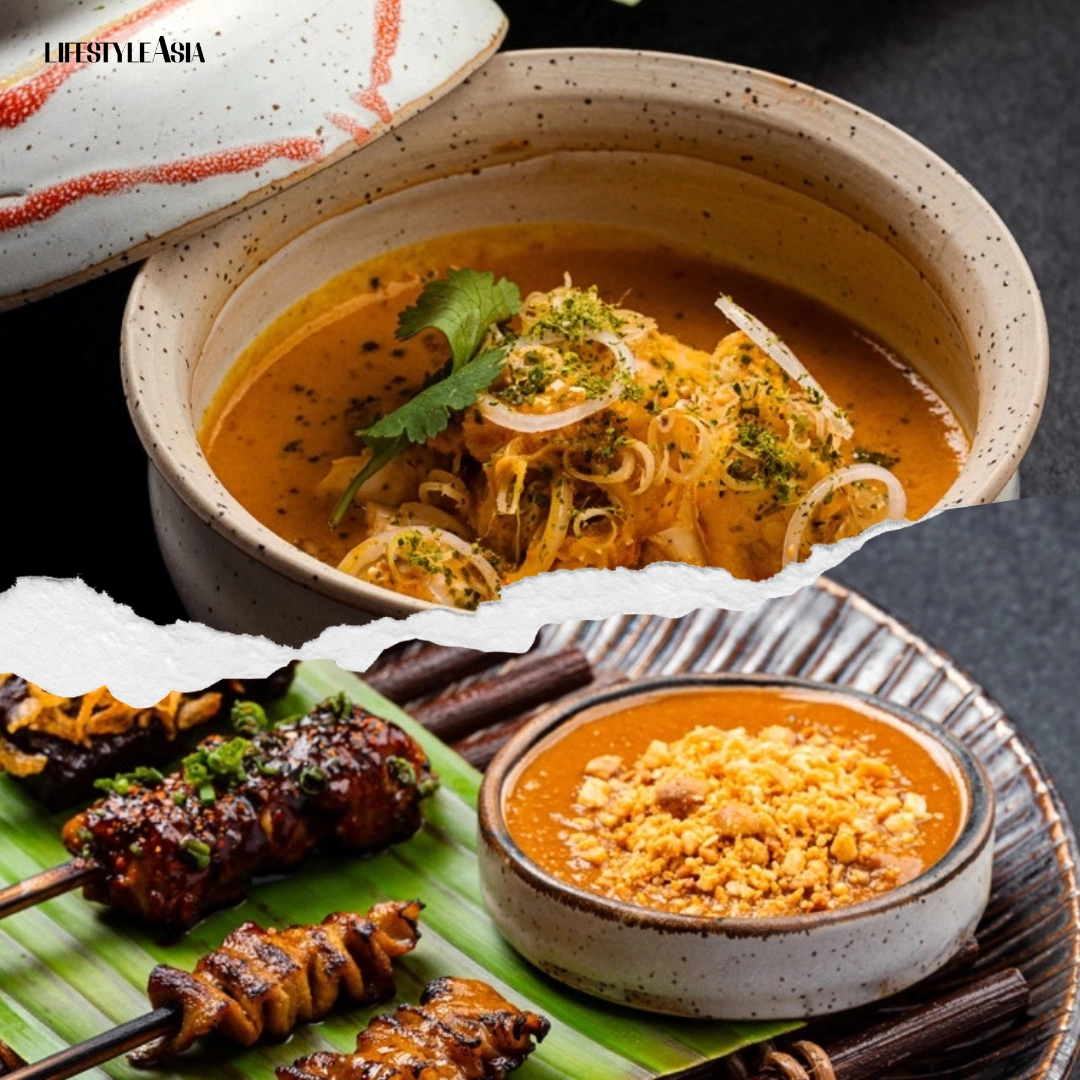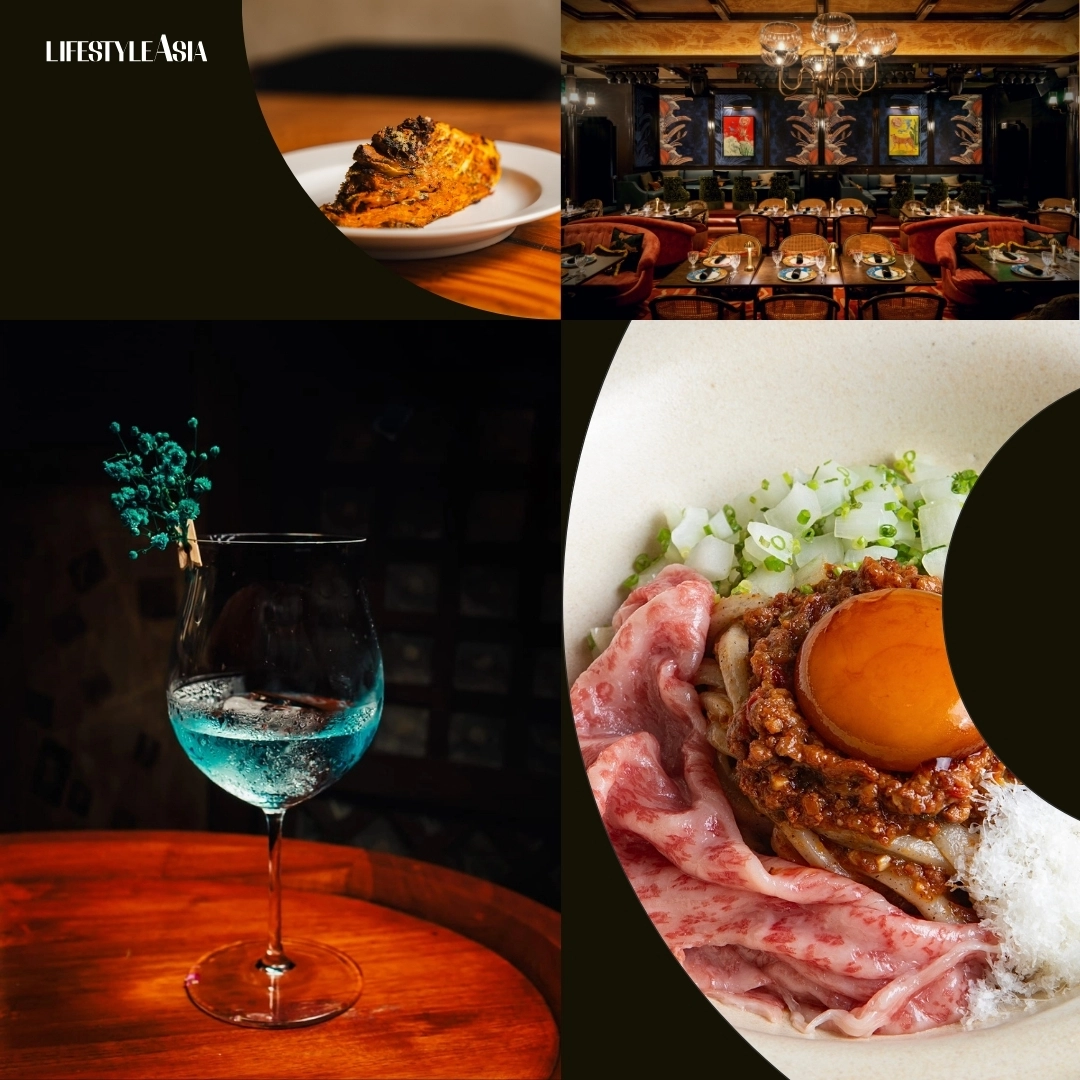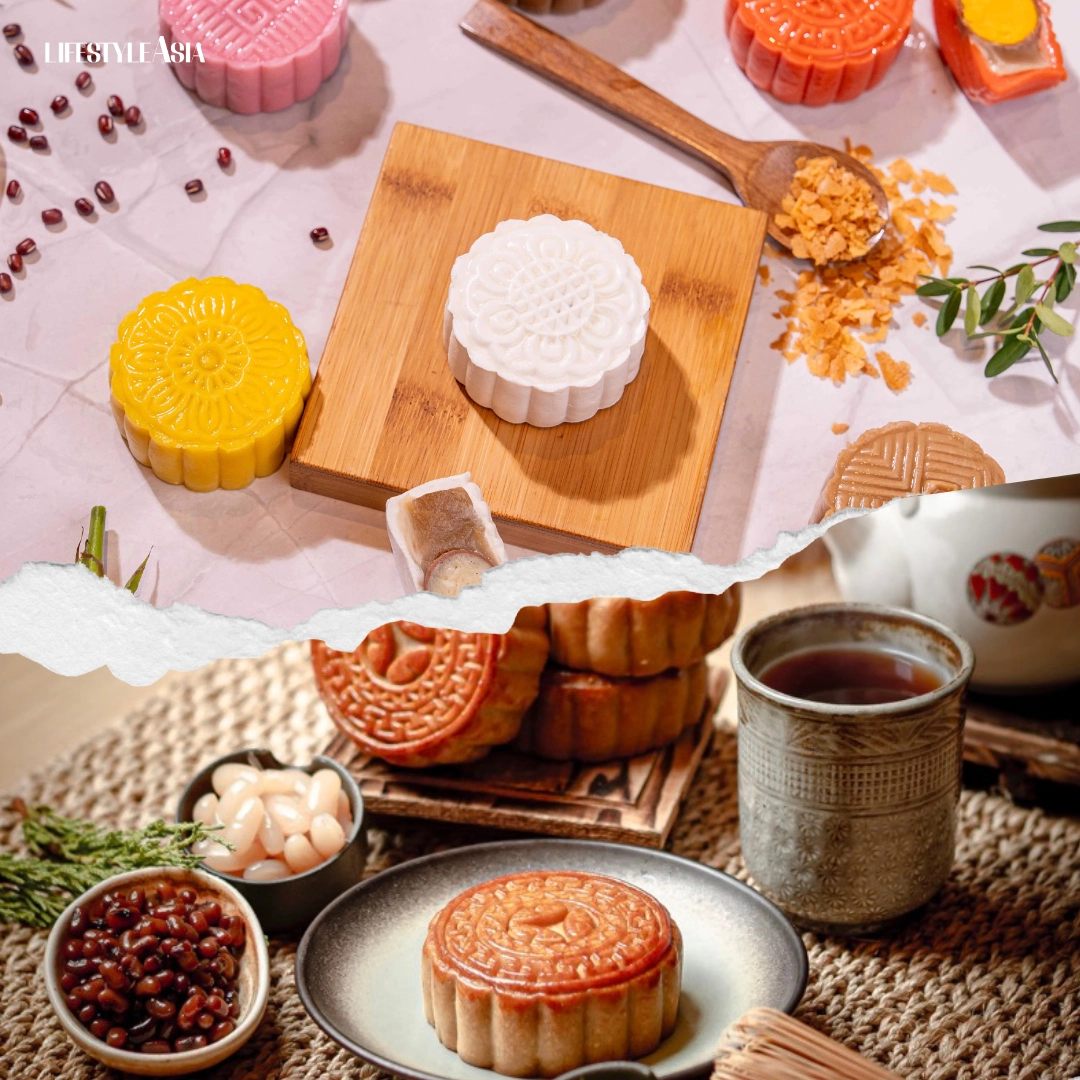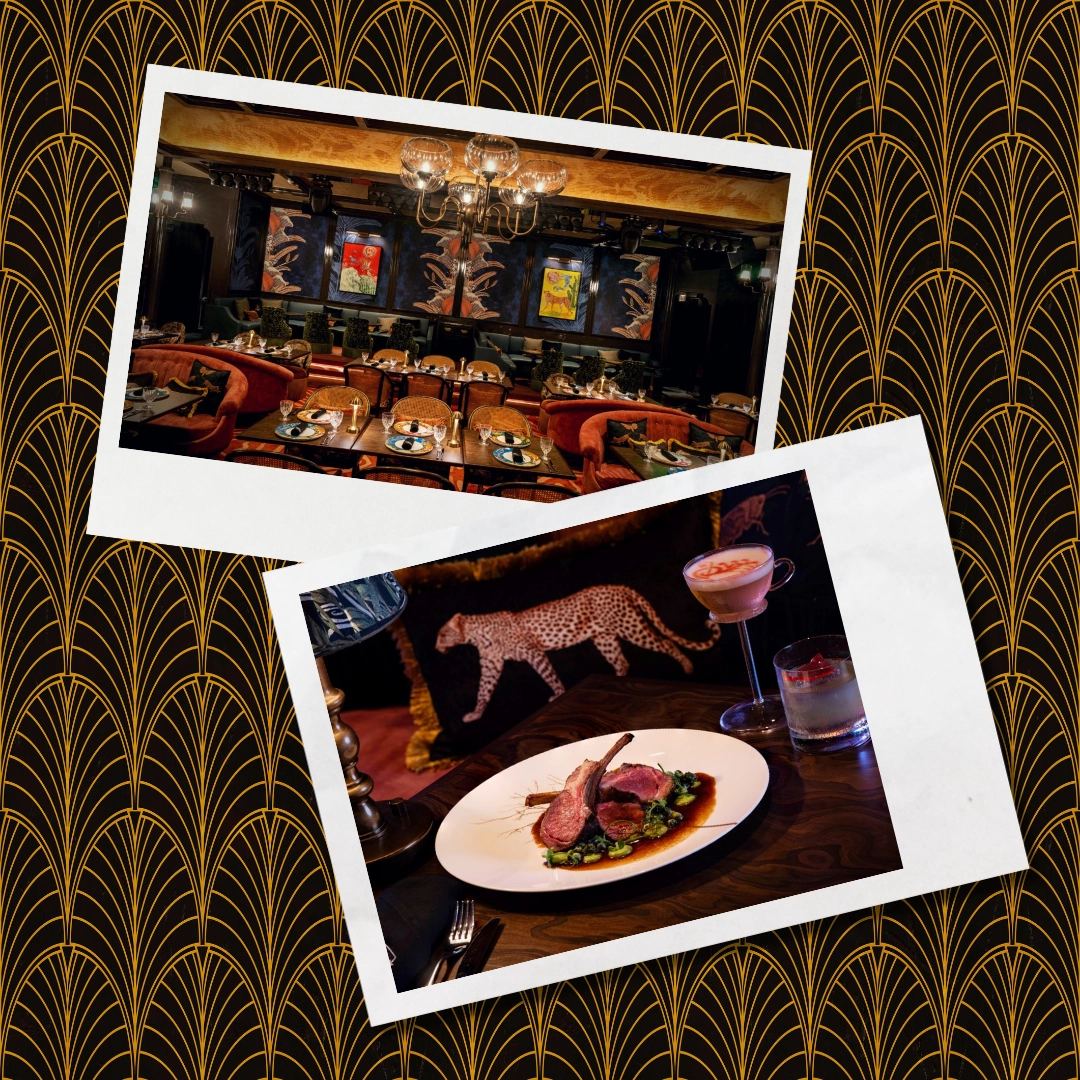Hapag welcomed Singaporean chef Malcolm Lee of Michelin-starred Candlenut and Pangium for a two-night collaborative dinner that spotlighted fresh, thoughtful takes on Filipino and Singaporean culinary traditions.
What links Singapore and the Philippines, beyond their shared corner of Southeast Asia, is this: their cuisines are mosaics that refuse to be boxed into a single category—layered, storied, shaped by generations of movement, memory, and mingling cultures. It’s what lends each country’s cuisine its richness, soul, and versatility. In the right hands, heirloom recipes and local ingredients can transform into something both nostalgic and freshly evocative, and that’s exactly what happened in the two-night collaborative dinner between modern Filipino restaurant Hapag and Chef Malcolm Lee of Candlenut and Pangium.
Titled “Hello, Malcolm,” the experience was part of the Singapore Tourism Board’s F&B initiative, SingaPob—a gastronomic takeover featuring award-winning bars and restaurants that showcase the Straits’ status as a culinary haven.
READ ALSO: Hong Kong Food Trip: 18 Restaurants In 4 Days
A Tale Of Two Countries
The collaboration had been “a long time coming,” as Hapag chef and partner Thirdy Dolatre describes. The team was supposed to work together back in 2023, though the timing wasn’t right. That said, Dolatre and his fellow chef and partner Kevin “Nav” Navoa are thankful it happened when it did.
“Looking back, that waiting period gave us both space to grow before coming together for this moment. We’re deeply grateful to the Singapore Tourism Board. This wouldn’t have happened without them,” Dolatre adds.
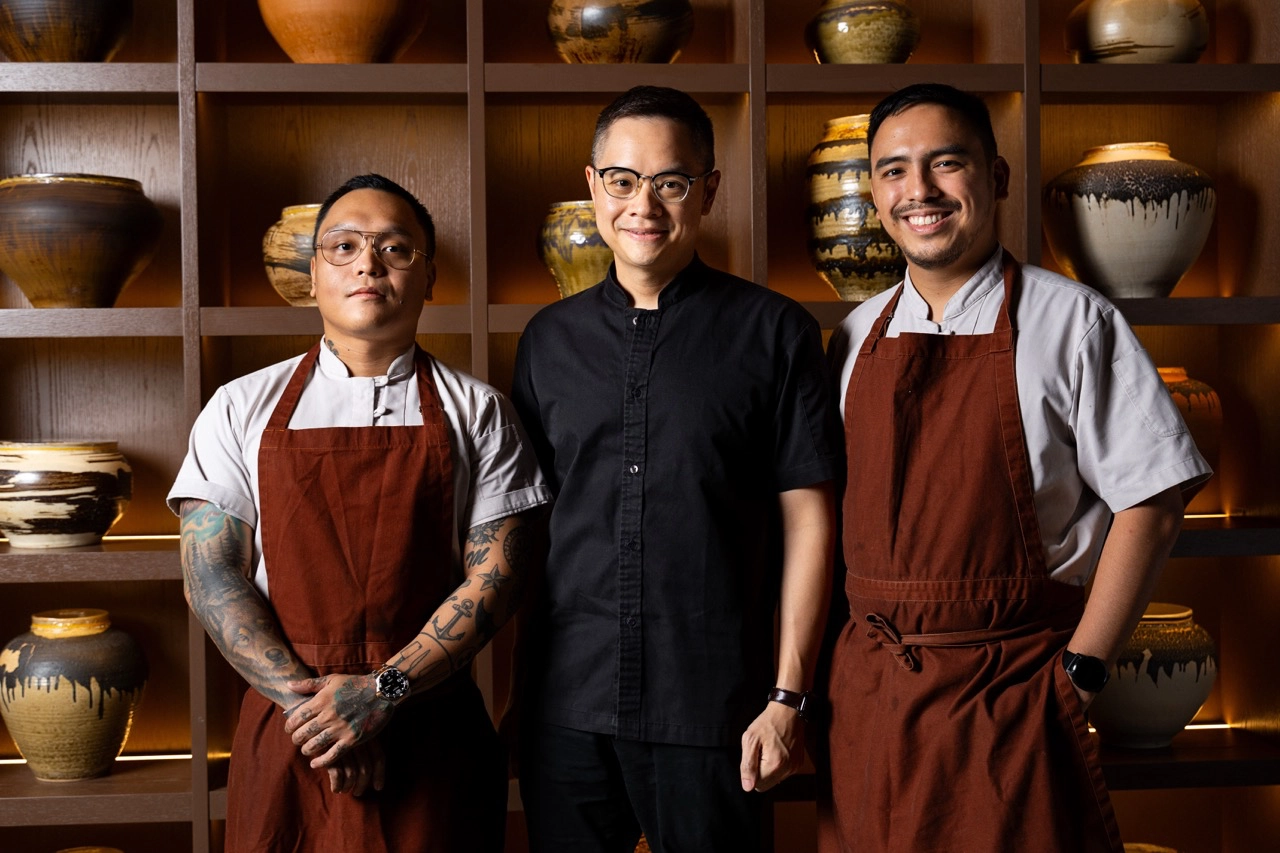
Besides being a part of the Singapore Tourism Board’s SingaPob initiative, the dinner was also born from Hapag’s goal of working closely with chefs, farmers, producers, and artisans. To Dolatre and Navoa, collaboration strengthens the dining experience as a whole, fostering an exchange of ideas and philosophies that can better shape a restaurant. The dinner marks Hapag’s third international collaboration at its new home in the Balmori Suites, and is part of an ongoing series that brings together top local and international culinary talents.
They couldn’t have picked a better chef to collaborate with: Lee’s ethos is one that’s closely aligned with Hapag’s spirit of honoring traditional flavors and ingredients while simultaneously reinvigorating them for today’s diners.

Lee is recognized internationally for helping place Peranakan cuisine on the world map through his distinctive, modern lens. In 2010, he launched Candlenut (known formally as Candlenut Kitchen), which became the world’s first Peranakan restaurant to earn a Michelin star. This was followed by the opening of Pangium in 2022, an intimate, tasting menu-only restaurant (named after the pangium tree that springs from the buah keluak seed) that earned its first Michelin star in 2024.
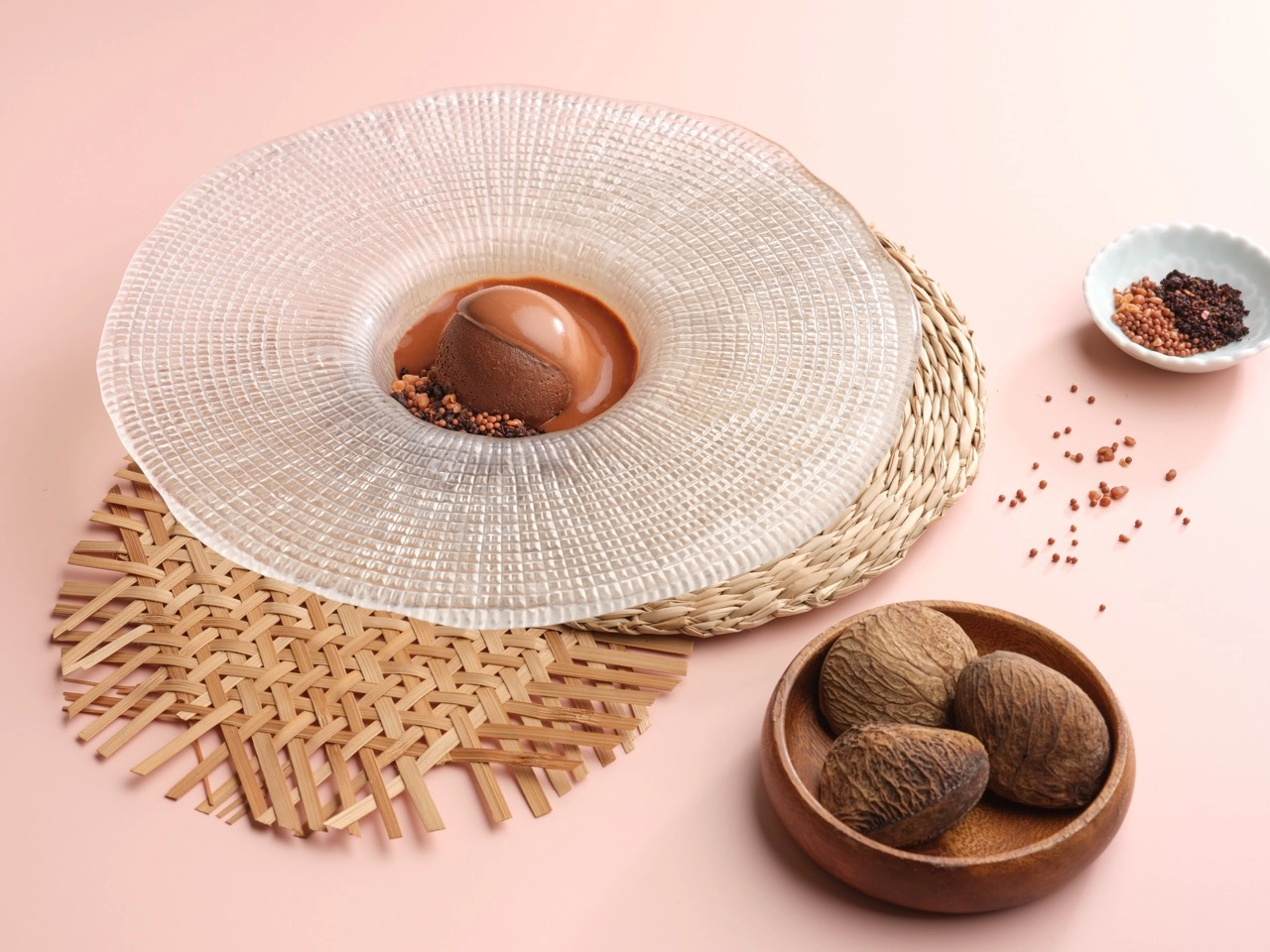
Through his work in Candlenut, the chef earned recognition for preserving the essence of heritage dishes from Singapore’s Peranakan community while adding contemporary twists that kept it relevant in the current F&B scene. “I hope to go further than just being local,” he explains. “If you delve deeper, there’s so much culinary knowledge that spans across generations and beyond the borders of Singapore. This rich regional archive of instinctive knowledge inspires me to ask questions, to discover the why and how we do the things we do—before it’s too late.”
The result is a pair of restaurants that treat cuisine not as a relic of the past, too sacred to be altered, but as a way of life—one that must be sustained through thoughtful study and continuous innovation.
Hello, Malcolm: What’s On The Table?
The collaborative dinner began with a soup course to whet the appetite and warm the stomach. Guests were served a rich broth of Tiyula Itum (inspired by a dark stew made by the Tausug people of Sulu), made by simmering beef tendon and bones with three kinds of fragrant ginger (galangal, ginger, and turmeric) and different spices that balanced the more indulgent flavors. This was topped with Bakwan Kepiting, a tasty Peranakan meatball composed of crabs, chicken, and bamboo shoots.
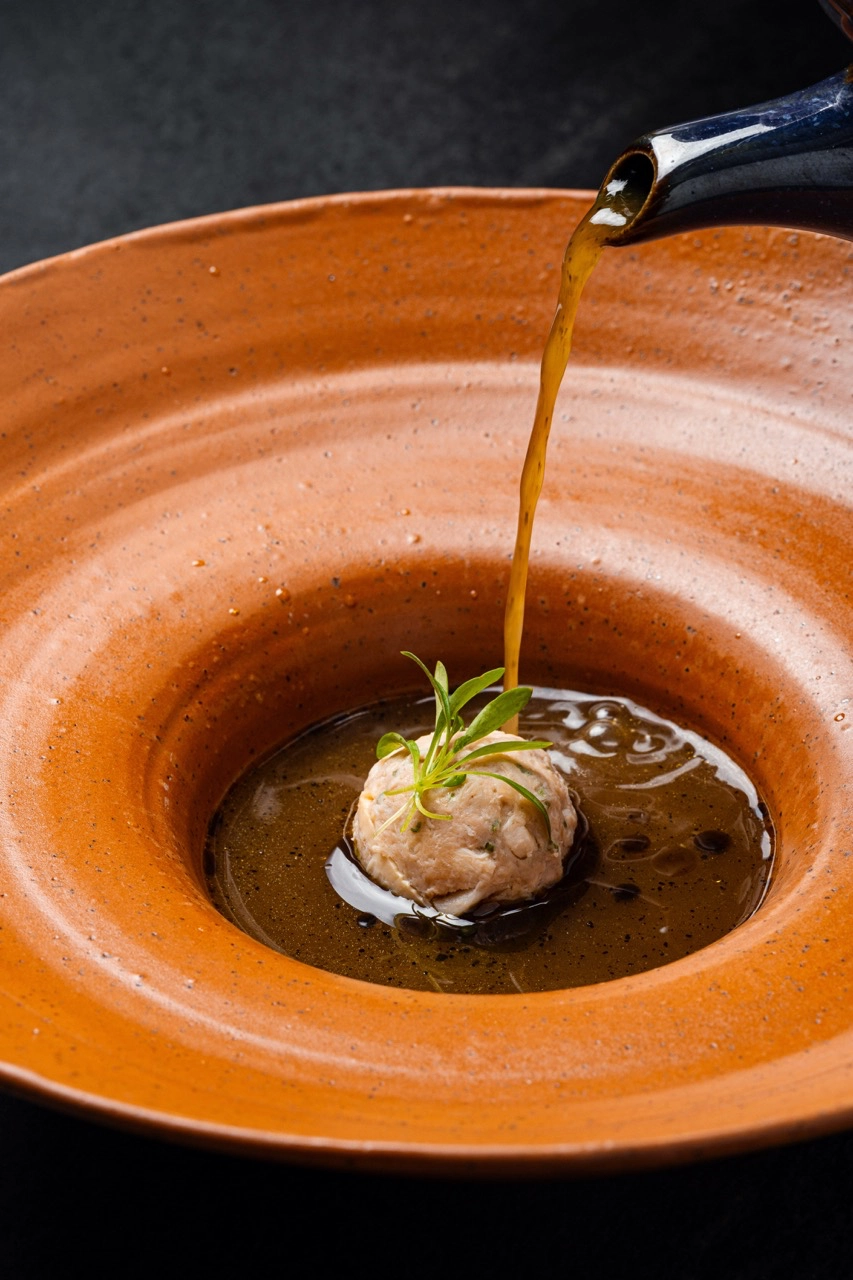
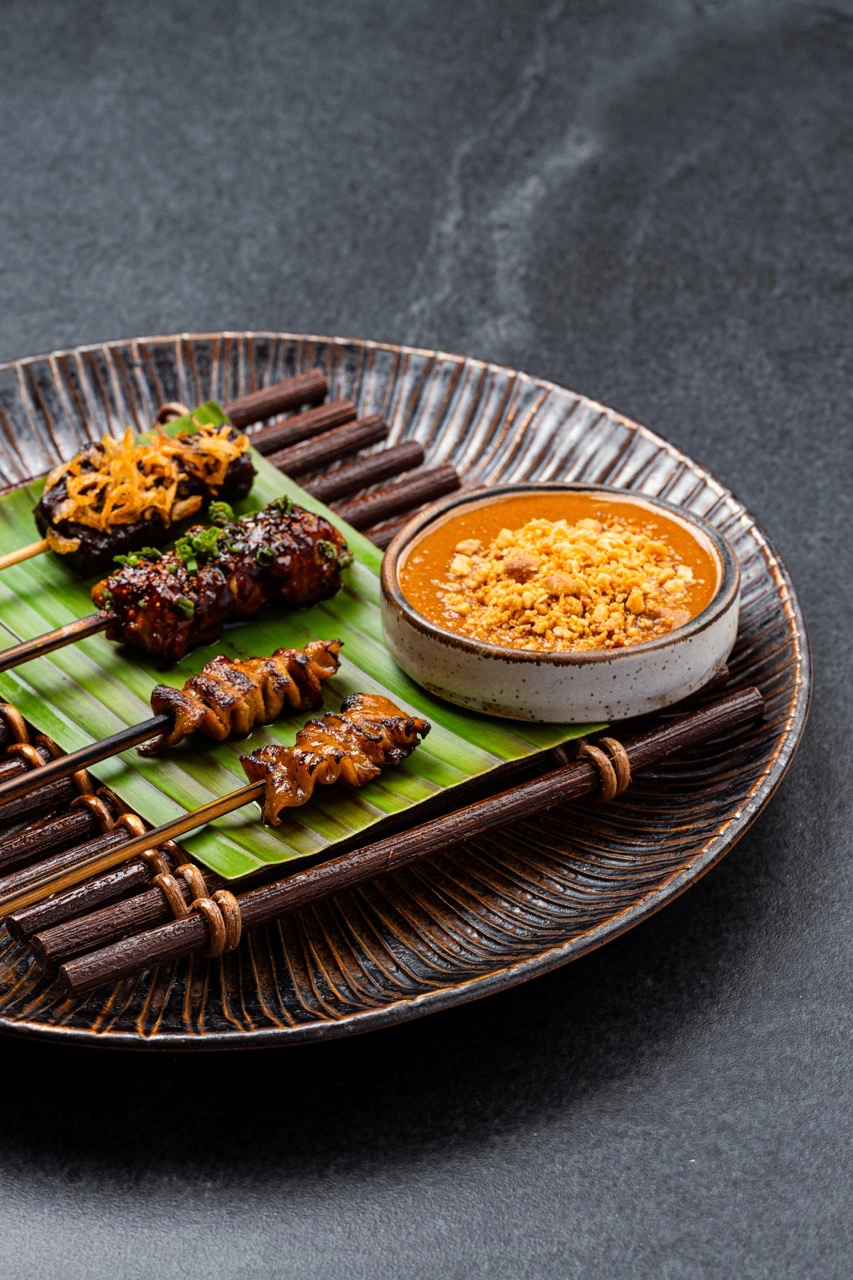
This was followed by the exceptional Satti x Satay, the name a blend of two terms used to describe skewers in Filipino and Singaporean cuisine. The “Satti” part was represented by chicken skin and beef tongue skewers that had a great bite to them, each glazed with cashew nuts and spiced satti oil. Their best characteristics shone when they were eaten with the creamy peanut sauce served on the side (made with pig’s brain, pork liver, and sand ginger). Meanwhile, the “Satay” featured pork shoulder and beef cheeks braised with spices and a sweet-savory kecap manis, which tied everything together with heavier, meatier textures. As I chose a wine pairing for the dinner, I was served a “Guy Charlemagne Rosé Brut Champagne Grand Cru ‘Le Mesnil-sur-Oger’” (made entirely from pinot noir) that perfectly cut through all the oil with its crispness.
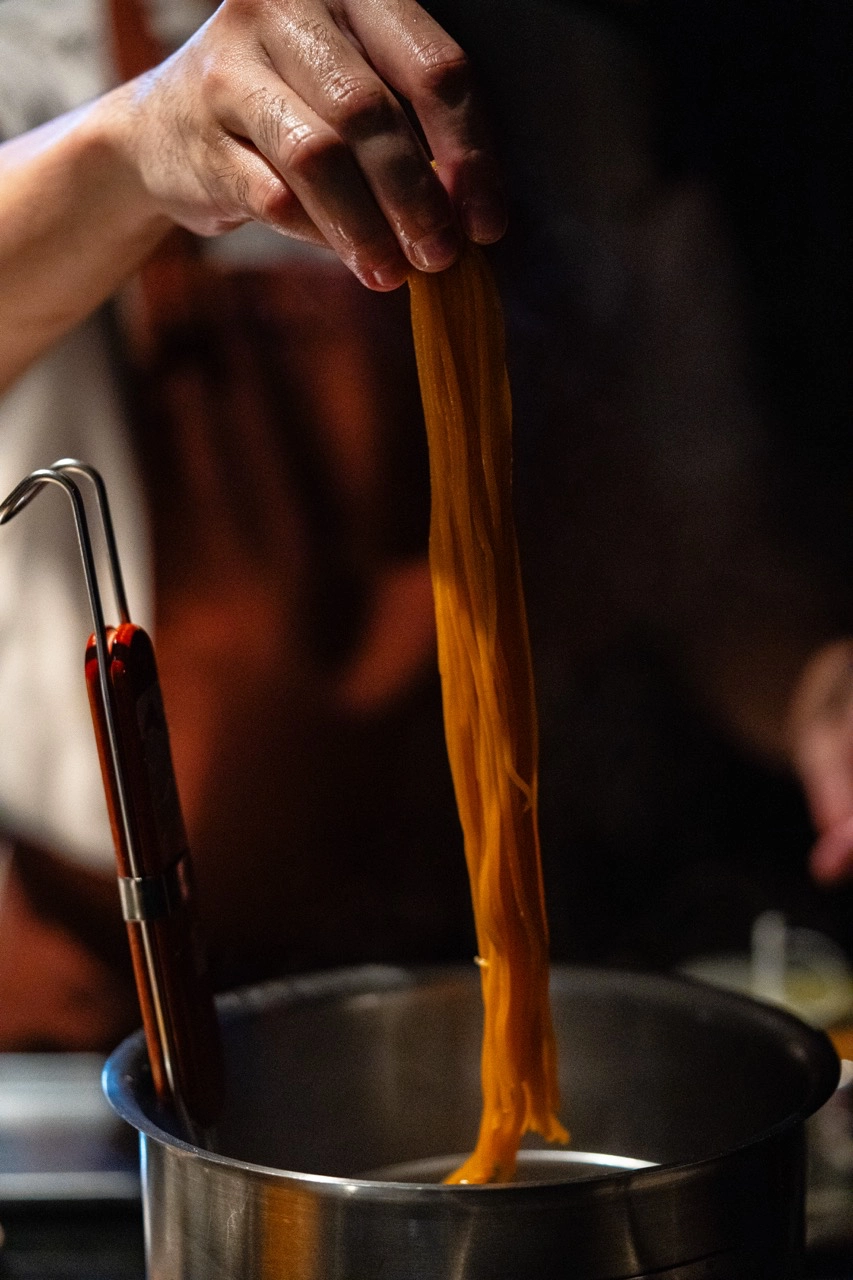

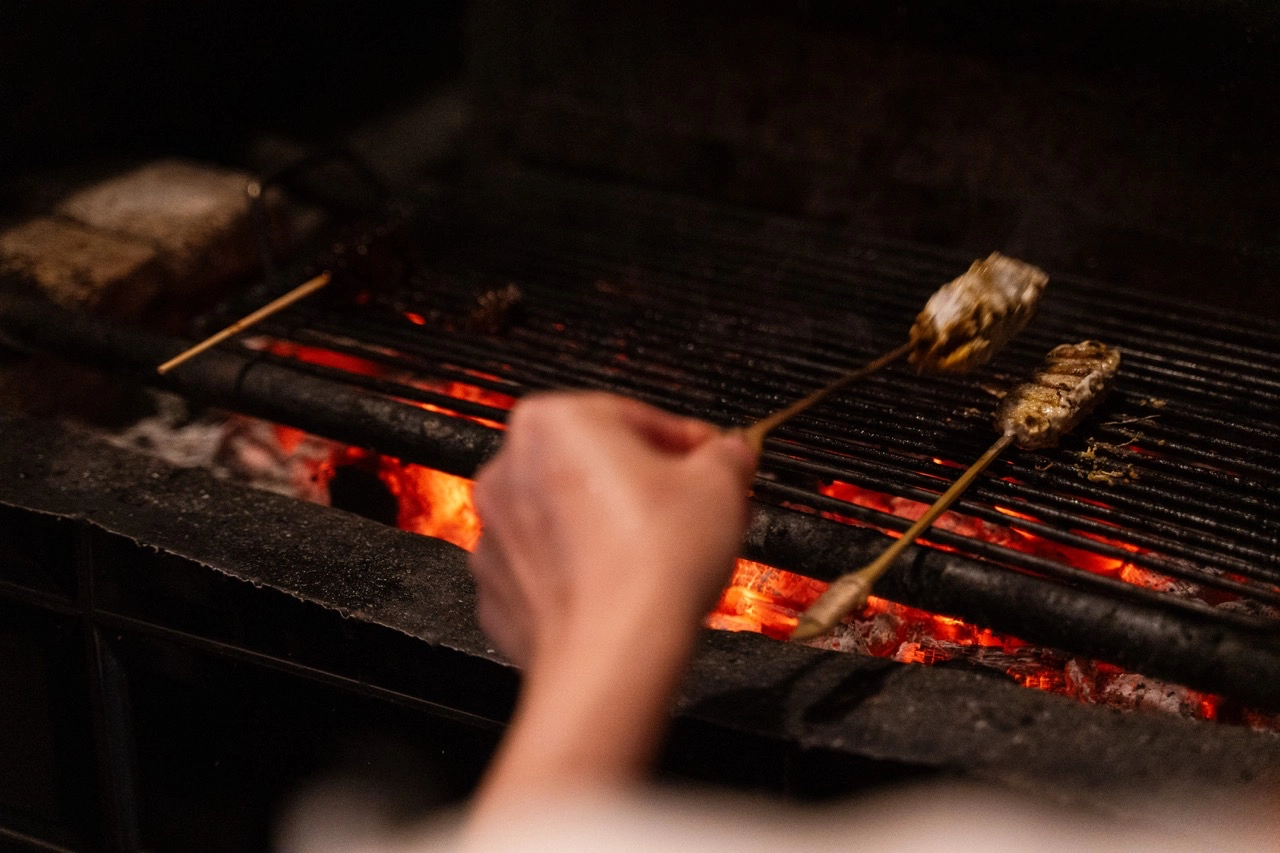
Not to be outdone, and an appropriately contrasting course right after the hearty skewers, was the Sinuglaw with Cincalok—a personal highlight. The word “Sinuglaw” combines the terms for two traditional ways of cooking in Filipino cuisine.
Sinugba means “to grill,” referring to the dish’s grilled pork jowl and pineapple; and kinilaw means to cook with acid (vinegar, citrus), referencing the fresh tuna kinilaw tossed in a tart and delightfully funky Cincalok (a Malay condiment similar to our bagoong, where shrimp is lacto-fermented). The result is a dish with all the right contrasting textures: slightly chewy bits of pork jowl, tender tuna, and a salad mix served with leche de tigre dressing mixed with tuba (coconut wine) vinegar.
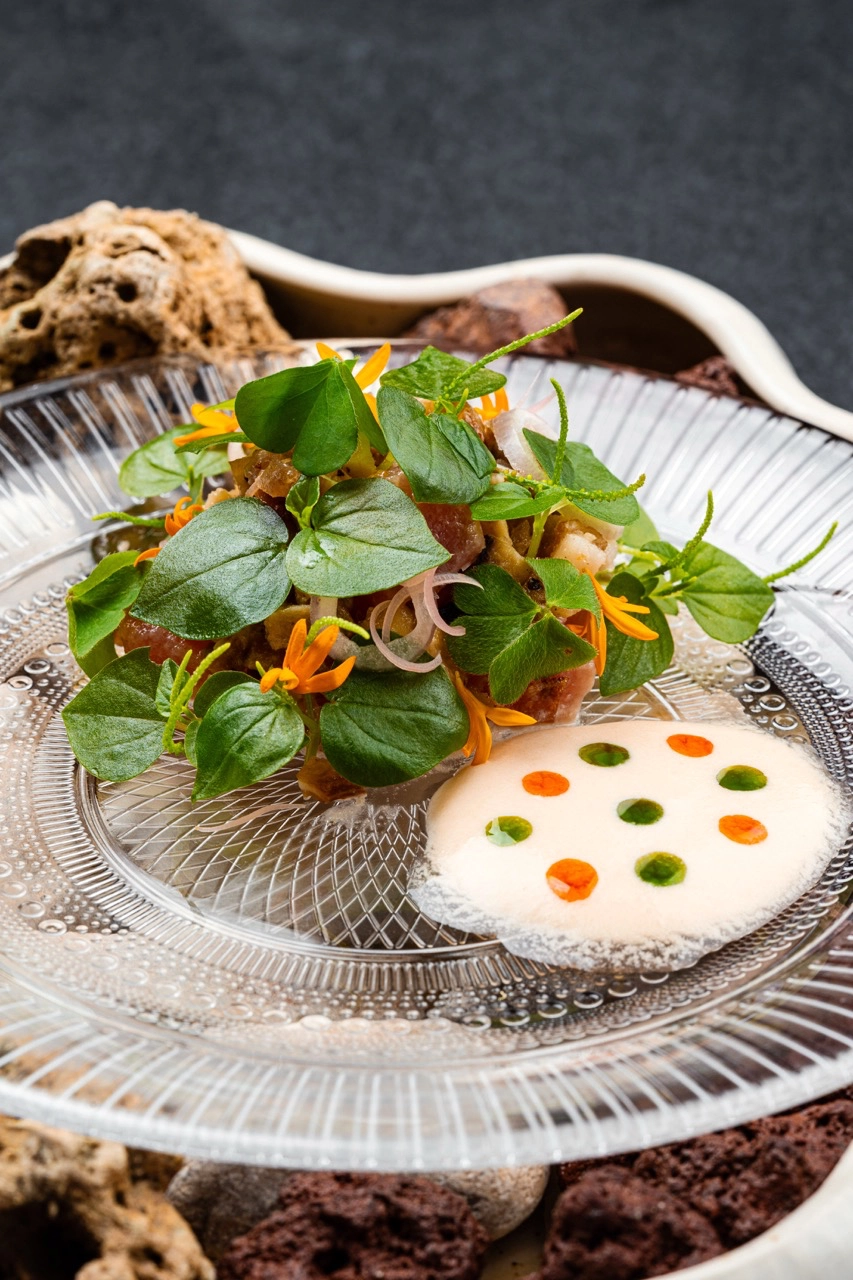
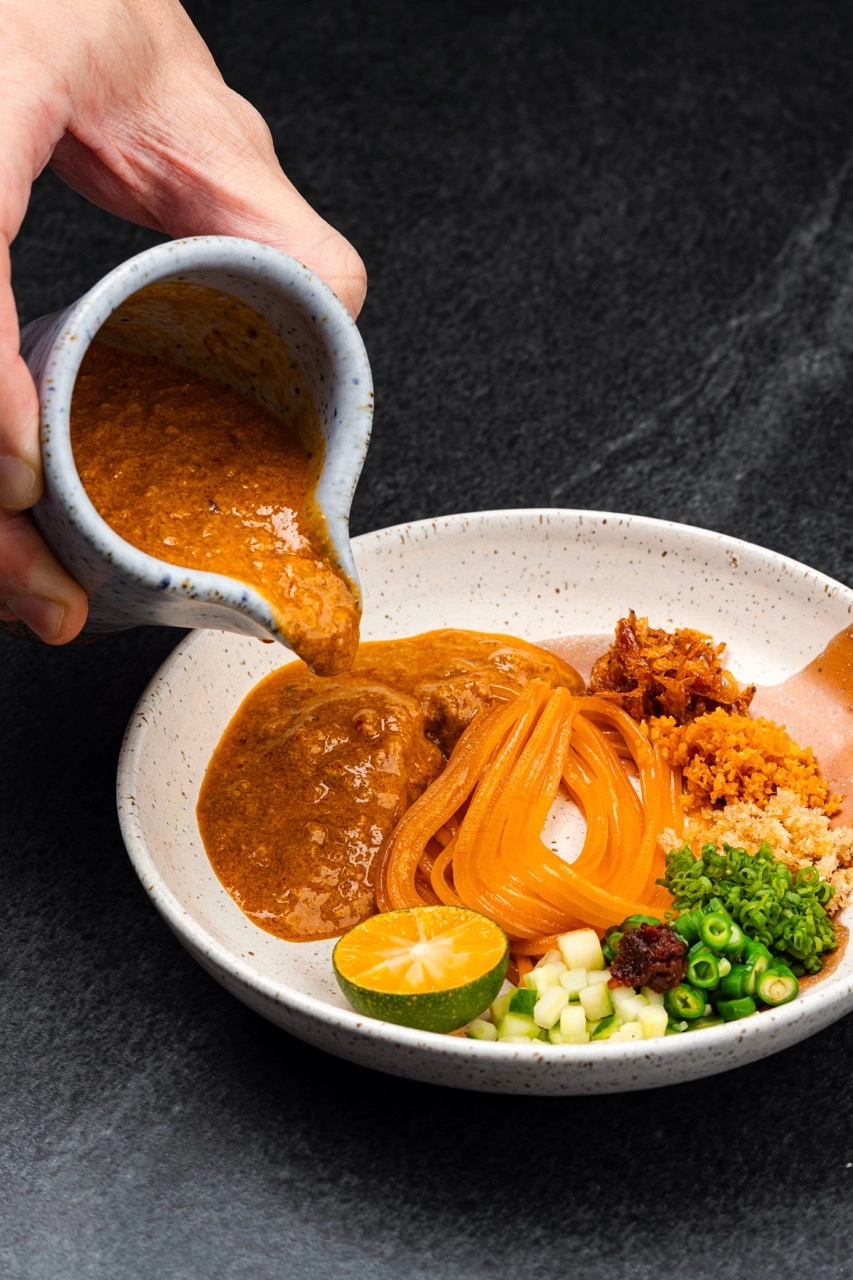
It may sound like I have too many favorites—but when every dish is a standout, it’s impossible not to. The Palabok Laksa kept the momentum going by combining the iconic noodle dishes of two countries. It was an unforgettable blend of house-made egg noodles, fresh cucumber, boiled string beans, fried kalkag (baby shrimp), chicharon sprinkles (because of course), and Candlenut’s special sambal. Finishing it off was a creamy rempah sauce made with prawn stock, coconut milk, and tinapa that you dream of bottling up and just dousing everything you eat with.
Both dishes were paired with a “2020 Selbach Piesporter Michelsberg Mosel DE,” which complemented the lightness of the Sinuglaw with Cincalok while balancing out the lushness of the Palabok Laksa through notes of citrus, lychee, and pear.
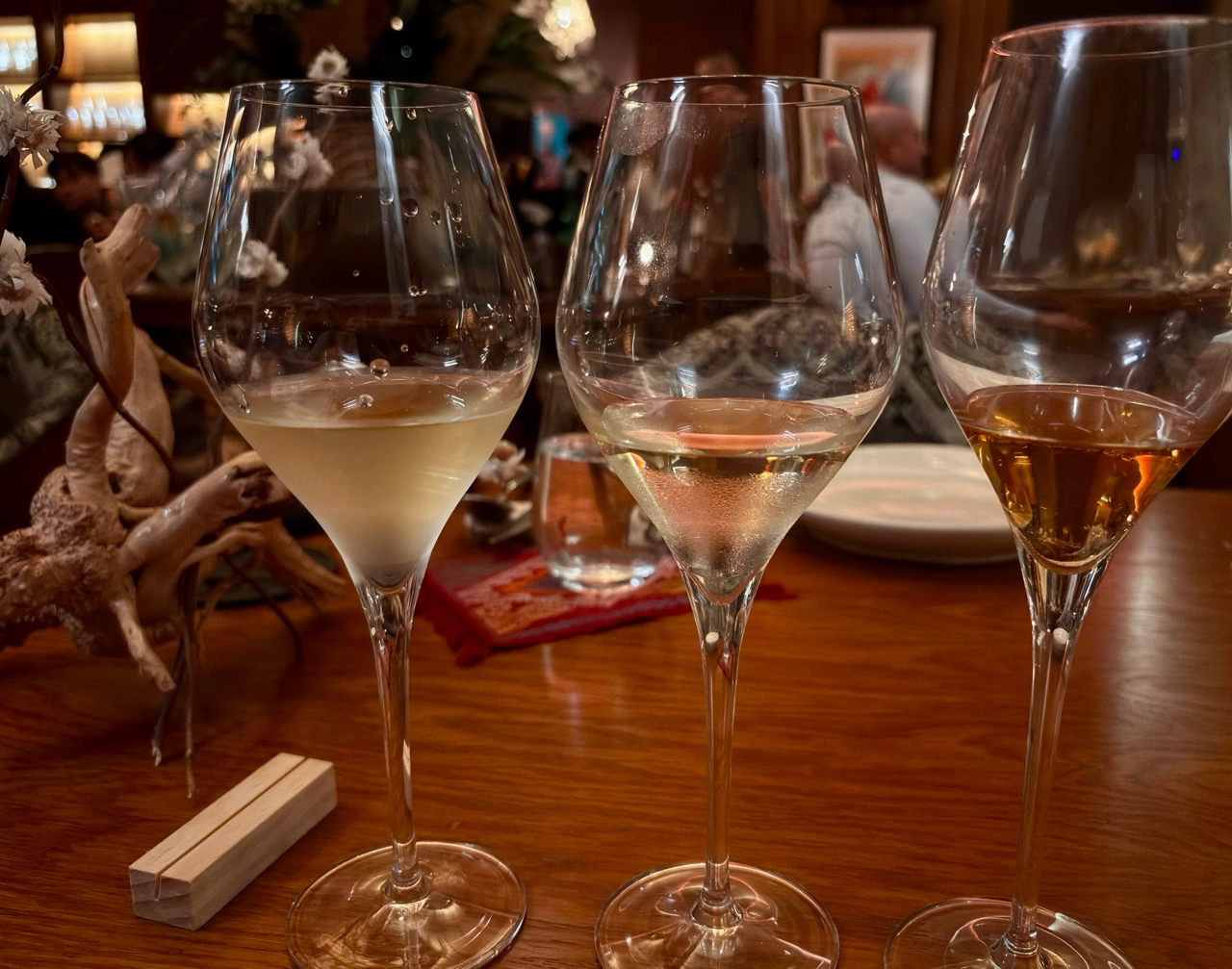
Even the palate cleanser of Star Fruit Leche Flan was a treat. Leche flan with dark soy syrup topped with calamansi and tanglad (lemongrass) granita, then laden with a refreshing star fruit sorbet and barley powder—with a very slight kick of chili gastrique (chili and apple cider).
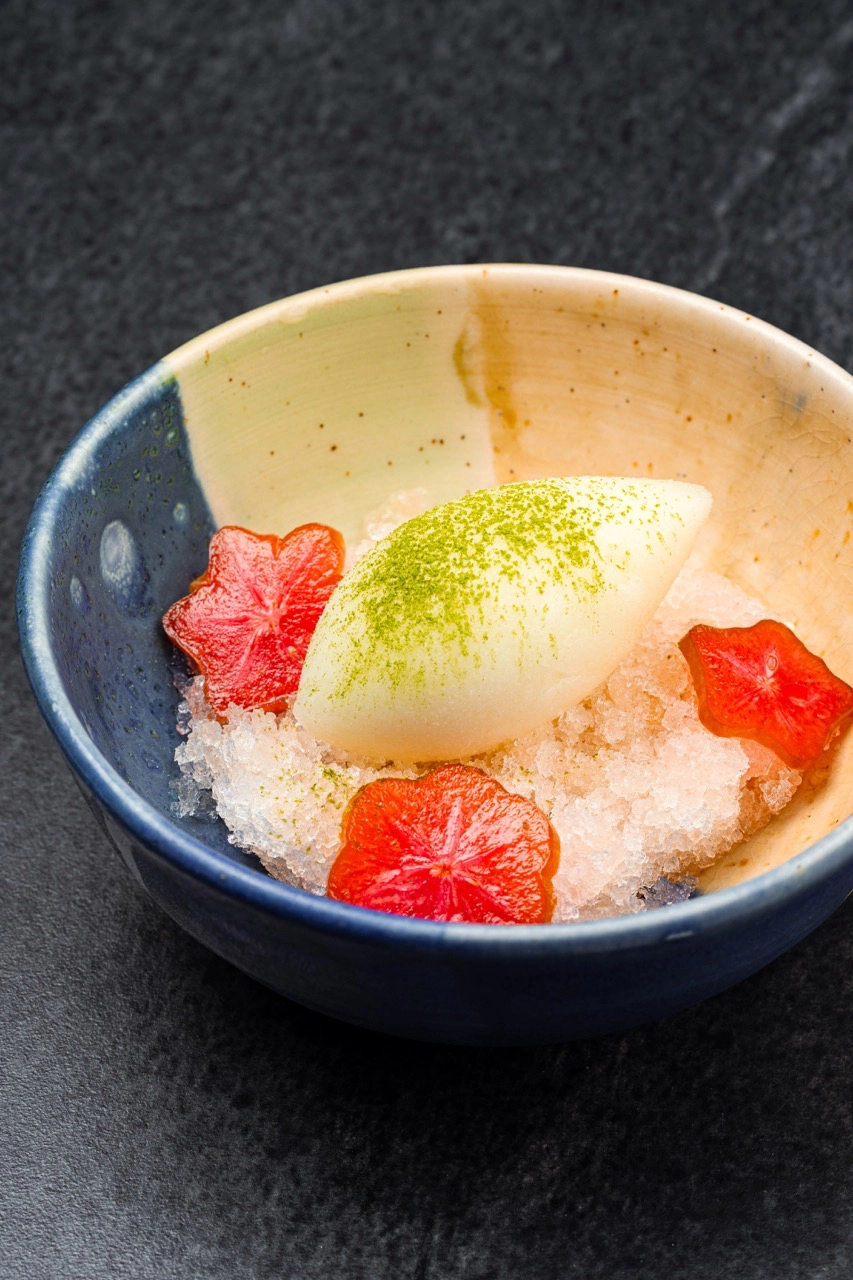
In true Filipino fashion, the main course was served salu-salo style, spread across each table for guests to pass around and share.
The Junay Rice Cake (the evening’s rice dish) could’ve been eaten on its own—cooked in chicken stock and turmeric, then topped with puffed black rice and a sprinkle of calamansi. The Camaron Alvar featured generous pieces of fried prawn served with a dip of sinfully good telur lemak curry sauce topped with fresh uni, while the Adobong Pusit gave the classic dish a new spin by replacing vinegar with tamarind.
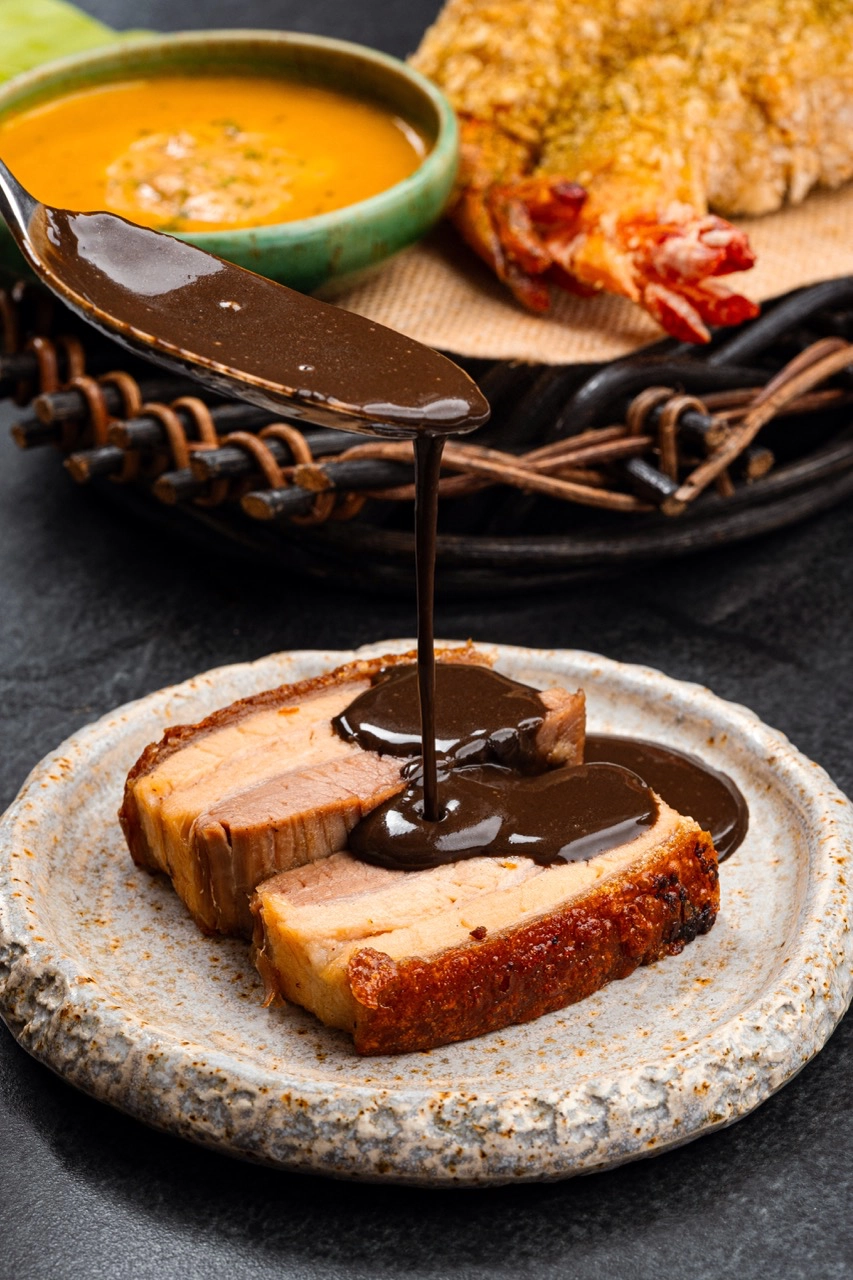
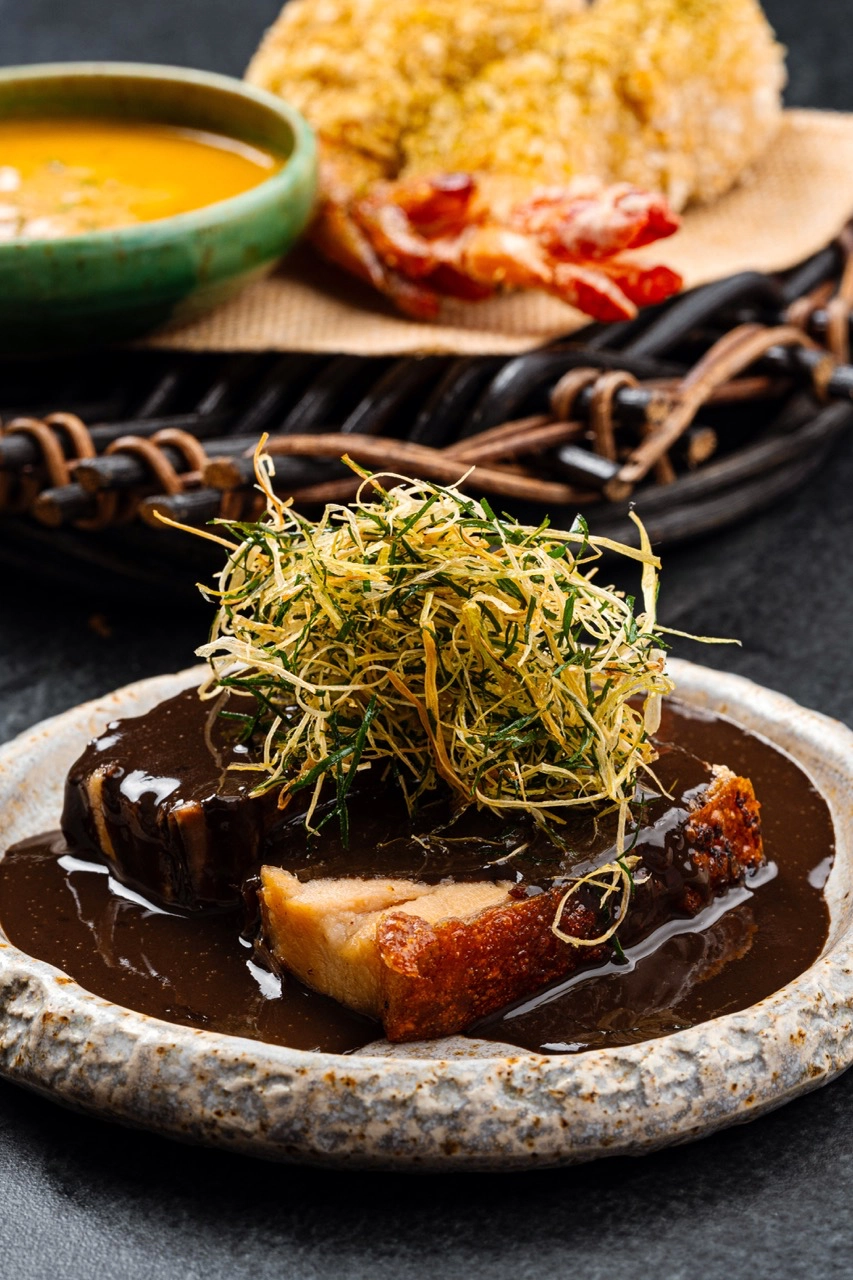
The Dinuguan offered something intriguing: crispy pork bagnet with a sauce of pork blood and buah keluak—a treasured black nut in Peranakan cuisine that lends an almost chocolatey, coffee-like depth to the dish. Fun fact: the nut, which grows from the pangium tree, must undergo thorough processing, as it actually contains cyanide compounds. (I’m alive and writing this article, so it’s nothing to worry about, and you should definitely try it when you get the chance to.)
Another memorable dish was the Crab Curry, which contained mouth-watering chunks of crab meat dressed in aligue and served in Candlenut’s signature curry sauce (delicate coconut milk with that subtle heat). Rounding out the course was the night’s source of fiber: an addictive Kerabu Salad made up of fresh pomelo, shredded guava, wing bean, toasted coconut, and shrimp floss tossed in kerabu—a traditional dressing made with citrus and sambal.
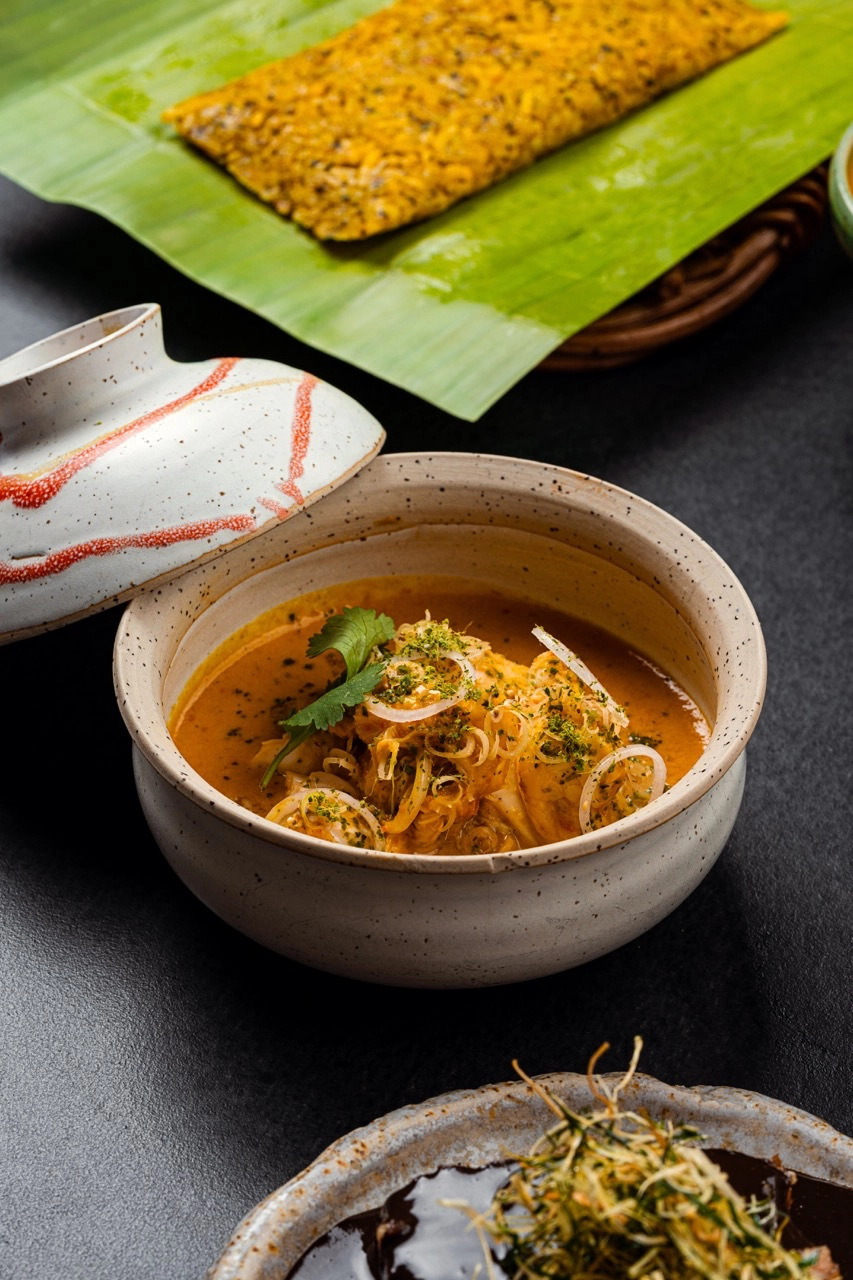
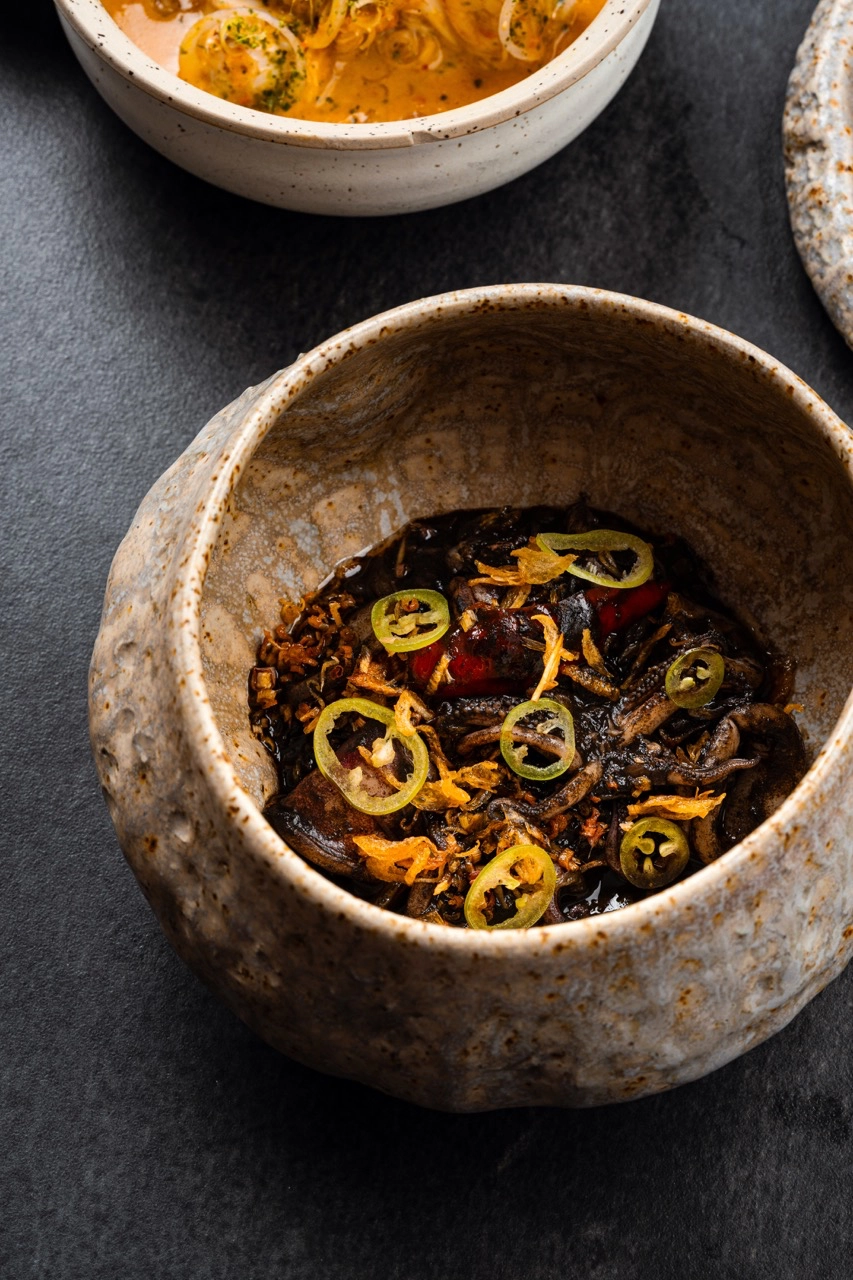
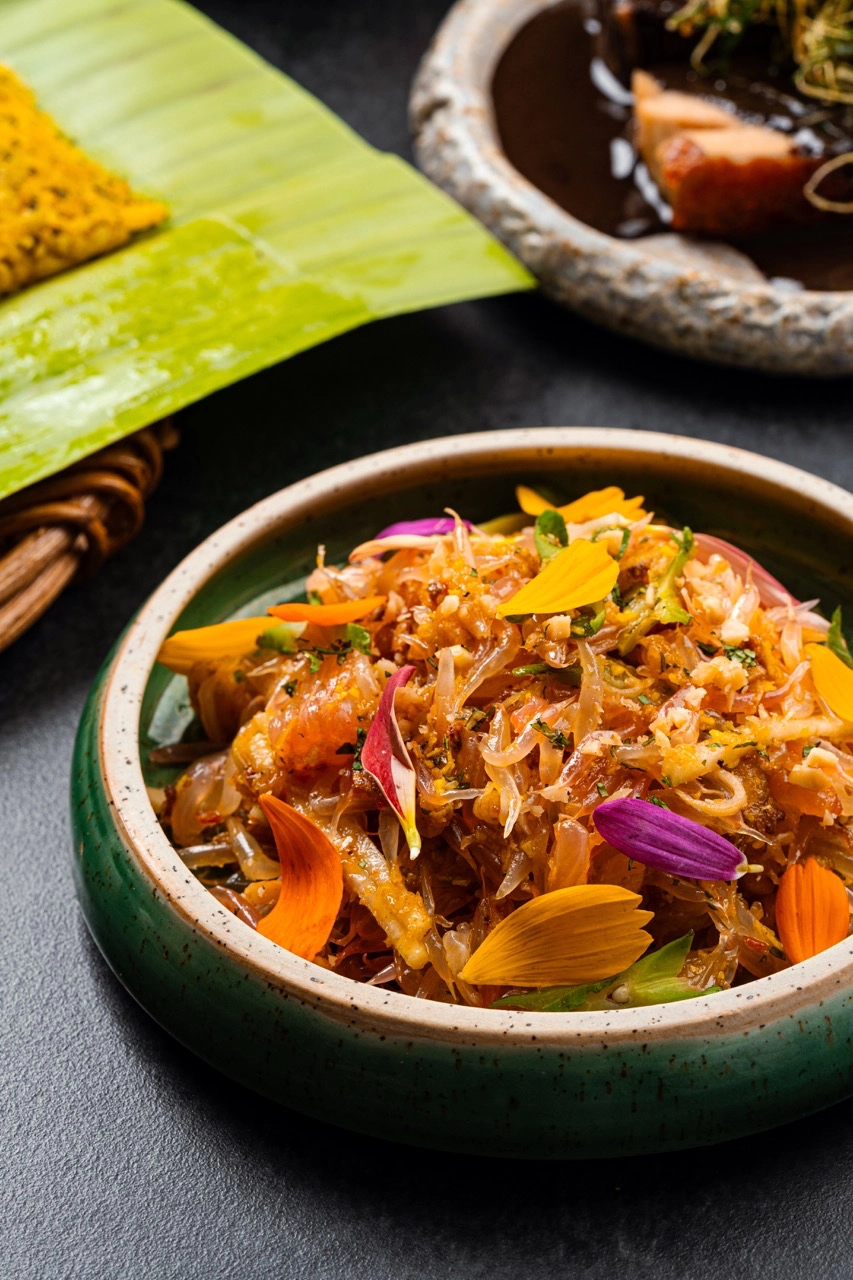

The salu-salo was accompanied by a “2021 Domaine Ogereu Anjou Blanc ‘Vent de Spilite’ Loire FR,” its high acidity a welcome counterpoint to the array of spices presented in the main course.
At this point, everyone at the table was thinking, “We can’t have another bite,” but we did. There is, after all, always room for dessert—and the evening’s selection ended the dinner on a high note. Desserts were paired with a sweet “2024 Pelissero Moscato d’Asti Piedmont, IT,” a pleasantly mild bubbly with fruity vanilla notes.
First was the Knickerbocker Cendol: think halo-halo’s demure sister, a mix of coconut sorbet, pickled longgan, lacto langka jam, cendol jelly, and mochi with coconut powder, finished with pili nut amazake foam and gula melaka (palm sugar that tastes like buko lychee).
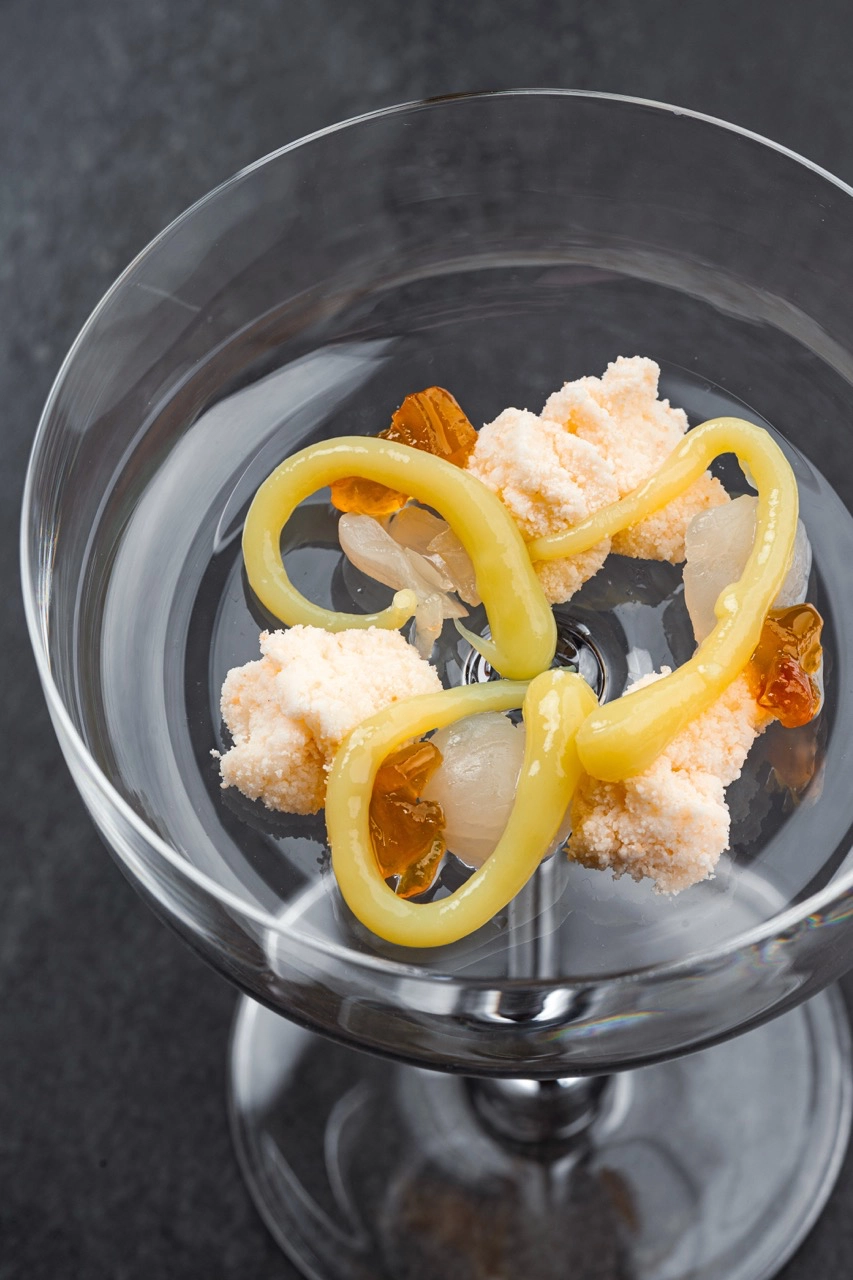
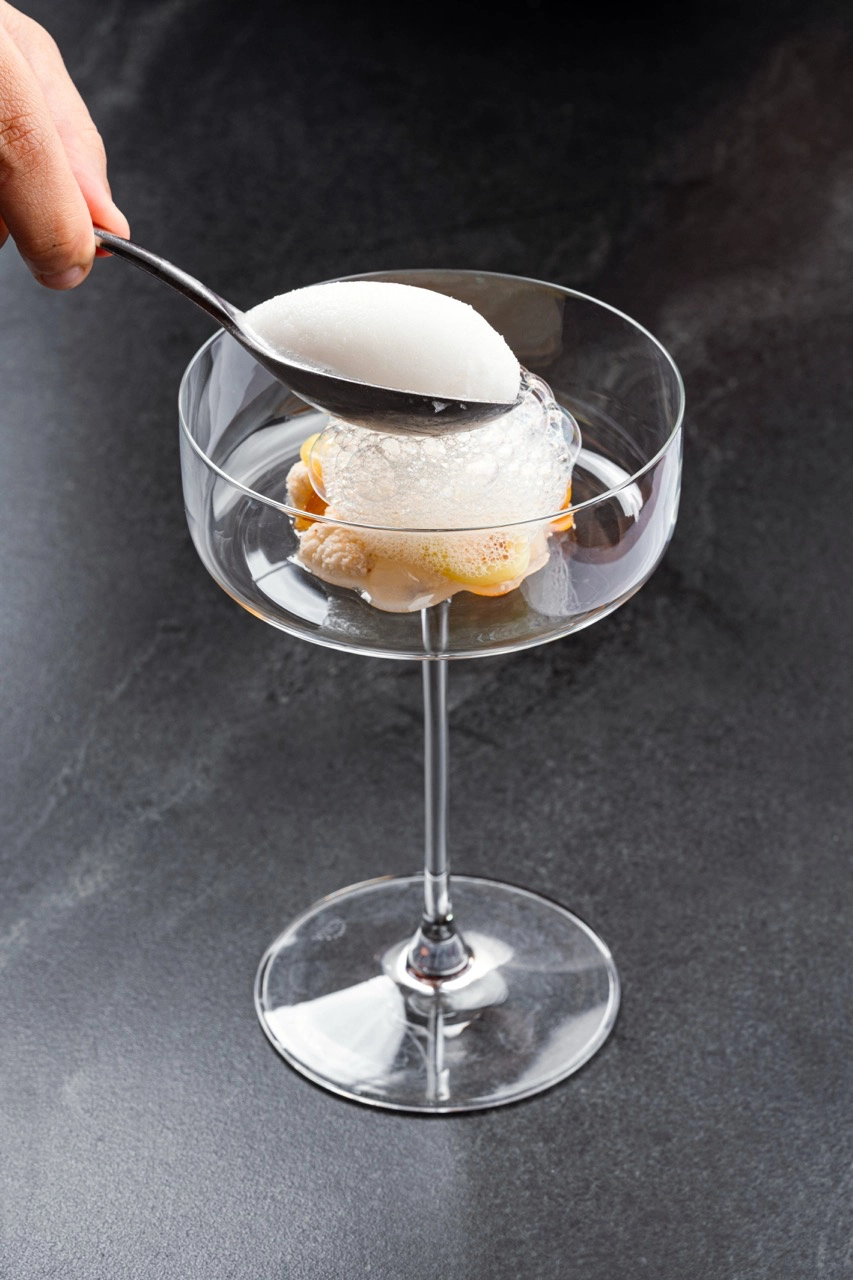
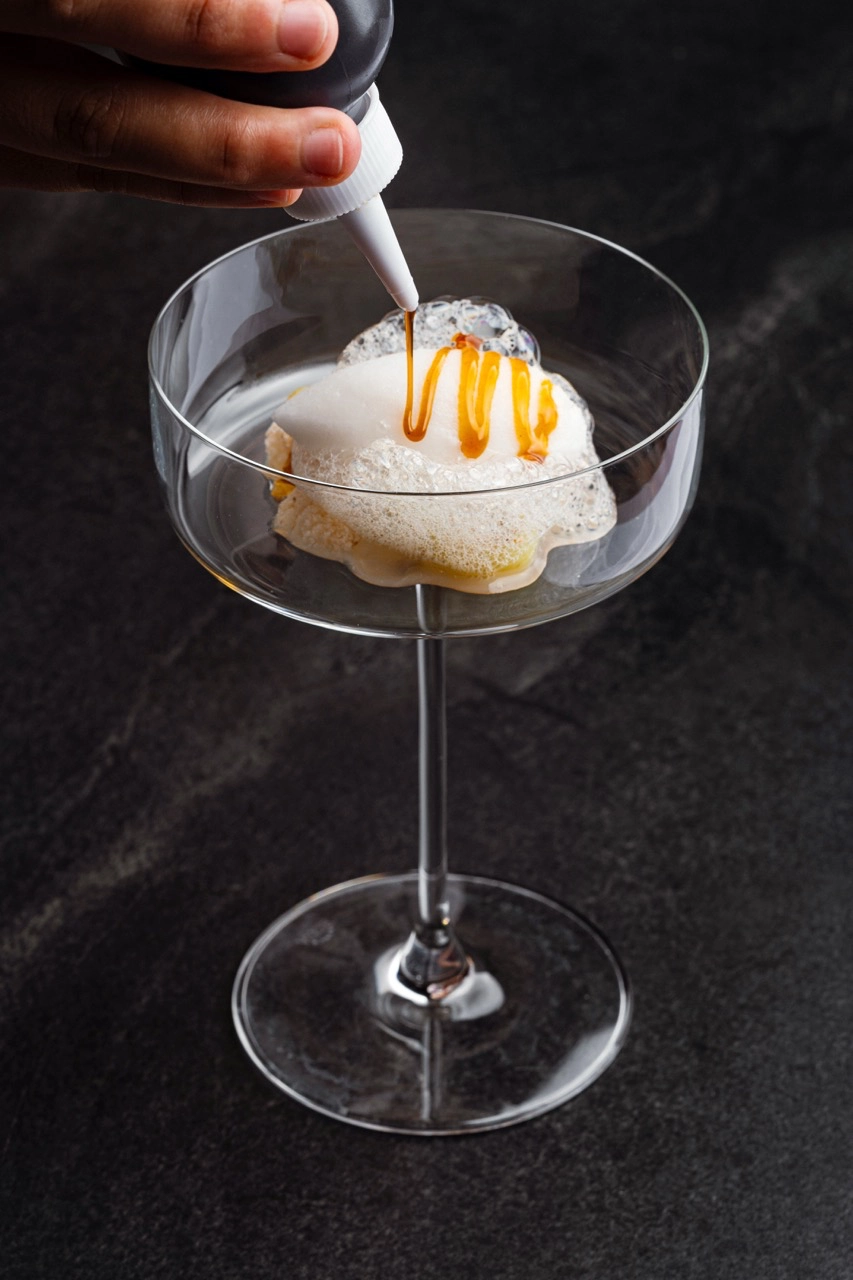
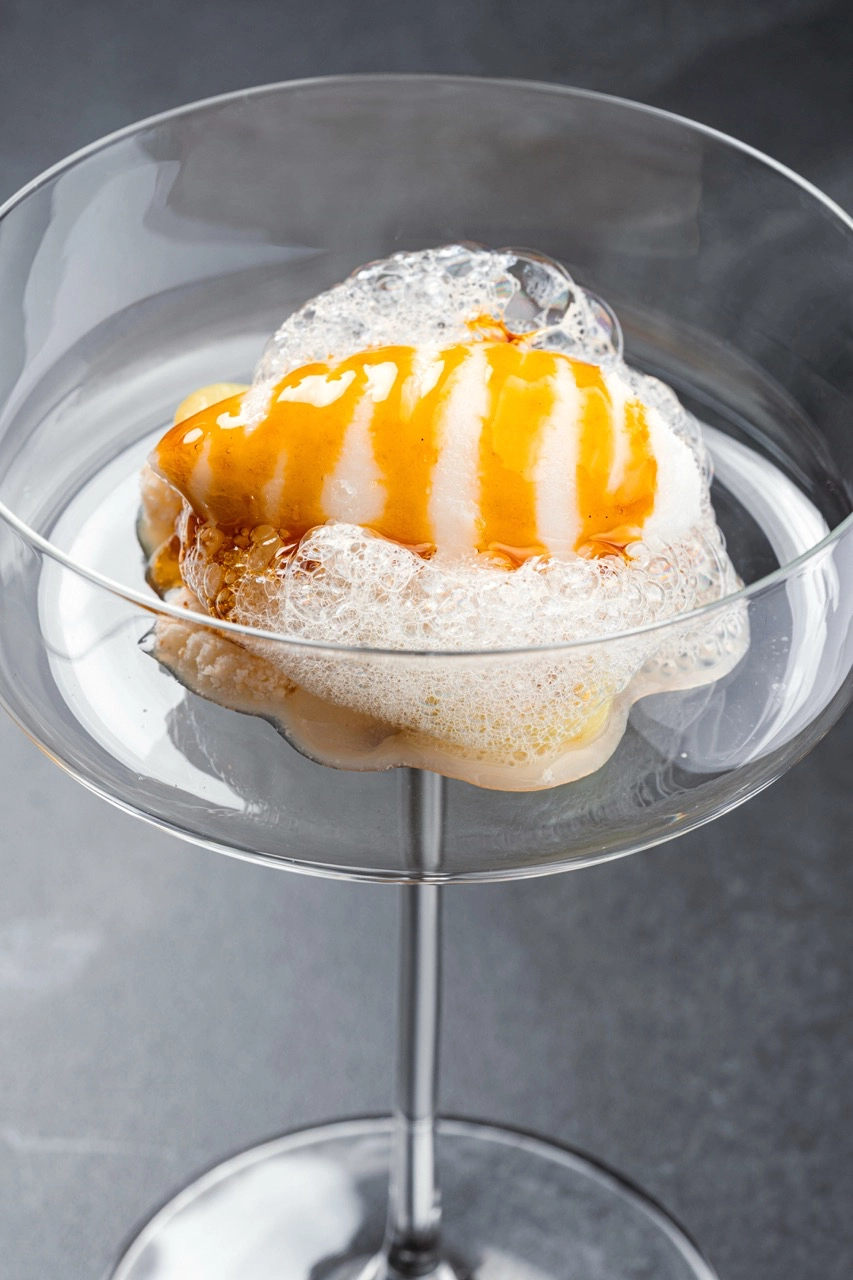
A visually-appealing conclusion to the meal, the Petit Fours were inspired by beloved Singaporean and Filipino snacks. These included the Biyaki White Chocolate filled with corn mousse and kernels (it became a surprising standout); Putli Mandi, which is like a palitaw filled with bukayo (sweetened coconut strips) then wrapped in kakanin dough, dipped in chocolate, and covered in freshly grated coconut; Kueh Sala (steamed glutinous rice) Coconut Pandan Custard; and a Dark Chocolate Bonbon filled with buah keluak and chili salted caramel ganache.
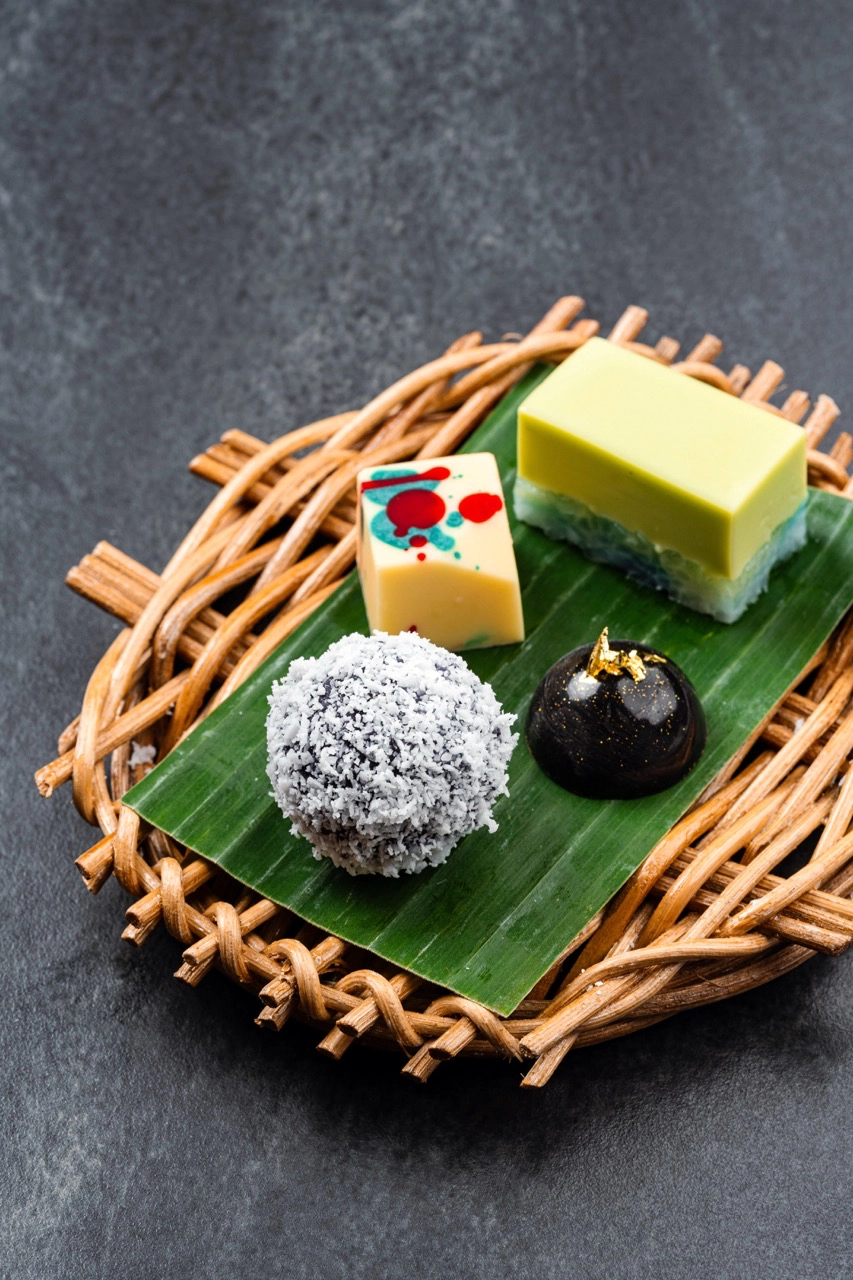
Seated beside both Singaporean and Filipino guests that evening, I was reminded of how food transcends cultural boundaries. A Singaporean gentleman marveled at the quality of Filipino pork; a Filipino woman raved about the comforting complexity of Peranakan flavors. In just one evening, a single dinner bridged the distance between two nations—it was, to put it simply, the kind of magic only a good meal can conjure.
Photos courtesy of Hapag and Eat Public Relations (unless specified).
